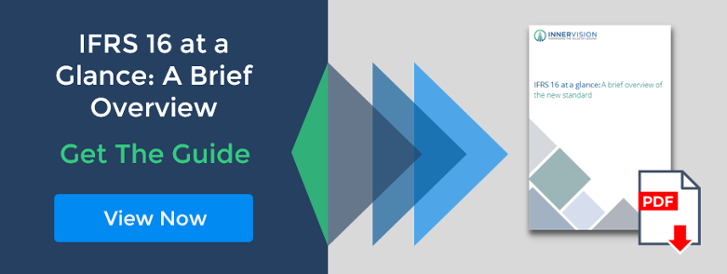The Pros And Cons Of Leasing In Light Of IFRS 16 Lease Accounting
Updated 26th May 2021 | 5 min read Published 5th October 2017

In a recent blog post, Why Lease As A Business, we looked into the pros and cons of leasing for business purposes. A running theme on the blog of late has been the merits of leasing versus other means of acquiring assets, such as hire purchase.
Something which your business needs to take into massive consideration, however, is how the new lease accounting standards which are only a matter of months away, called IFRS 16, will affect your decision on whether to pursue leasing. The benefits of leasing equipment might grow on the one hand in light of IFRS 16 but they also might diminish on the other.
Benefits Of Leasing Equipment Generally Speaking
Businesses across all industries and sectors use leasing as a means of using assets ranging from cash tills and computers to planes, trains and automobiles. The beauty of leasing is that the business gets exclusive use of the assets and to treat them as their own - but without any of the ownership responsibilities, any of the disposal or recycling concerns and with a much, much lower upfront cost.
At the end of the lease agreement, the asset is handed back to the legal owner (the lease provider) or a new agreement can be worked out.
Besides the flexibility offered by not being responsible for disposing of a now no longer needed asset - trying to find a buyer; negotiating a price; ongoing, increasing maintenance and servicing costs - there are financial benefits too.
Cash Flow is more easily managed under a lease agreement because barring unforeseen damage or misuse the monthly payments for the asset are fixed well in advance. Also, the asset owner may have a responsibility to pay for and arrange general and scheduled maintenance, similar to when you rent a property and the landlord is responsible for a leaking roof for example.
There are also more intricate financial benefits, historically, such as being able to keep operating lease agreements off the balance sheet of a company – the use of the equipment does not result in either a liability or an asset on the balance sheet. Quite often, the payments of the lease agreement are expensed and perhaps tax deductible too.
How IFRS 16 Impacts Businesses Lease Agreements & Management Of Lease Portfolios
The biggest, headline grabbing change as a result of IFRS 16 lease accounting standards being implemented is that both operating leases and finance leases (capital leases) will be recognised on balance sheet.
It’s estimated that this change will bring £1.7 TRILLION onto balance sheets around the globe and it will have an effect on company asset turnover, interest cover, operating profit, net income, cash flows and a range of other financial ratios.
Your business’s financial reporting, forecasting and decision making will be greatly impacted.
What has surprised many companies operating in line with the IASB (International Accounting Standards Board) standards is how complex and enormous a task becoming compliant will be. As well as the work involved being extremely time consuming, the impact is potentially huge, due to the aforementioned areas impacted.
It’s reported that 70% of companies have appointed a dedicated IFRS 16 Project Manager to make sure that financial metrics and reports are not harmed by IFRS 16 and their business is in the strongest possible position when it comes to their lease portfolio performance.
Alarmingly, the same survey indicates that 25% of companies, as of March 2017, had not begun preparations for implementing IFRS 16 which comes into full effect on 1st January 2019.
The lack of preparation is particularly concerning when you consider that some lessees will need to produce comparative balance sheet reports for profit and loss before and after the IFRS 16 implementation.
Other changes of note include the fact that the definition of what constitutes a lease agreement and what constitutes a service agreement is changing. This means some agreements which are currently services will become leases and vice versa. This then means, in turn, that a full assessment of your agreements needs to be made in order to see what’s what and where it should be reported.
If your agreement data is widespread or poorly organised, this means that the pressure is on to be able to even start drawing a line in the sand and establishing a lease reporting starting point – before moving to compliance you need to know where you are today with regard to the new standard.
In recognition of the size of the task, the IASB is providing transition reliefs to companies in order to ease the financial burden of transitioning to this new way of accounting for leases.
Why Lease Equipment After IFRS 16
All of this may, understandably, leave businesses wondering why they should lease equipment after IFRS 16 at all. But this is to ignore the fact that leasing still offers all of the flexibilities and certainty of cash flow benefits that it always has, as well as still giving your business the ability to access premium assets at a lower monthly expense than if you bought them outright – the benefits of use without the detriment of ownership, the ability to match cost as income from use is realised.
Secondly, the fact is that many businesses now rely on having an extensive lease portfolio in order to be able to operate in the way that they do. To suddenly have to switch to hire purchase or bank loan agreement in order to own assets would be an even bigger sea change than accounting for leases in a new way.
The intention of IFRS 16 is not to dissuade businesses from using leases, but rather to make sure that the way they are accounted for is represented in the most transparent way.
If you are one of the 25% of businesses which is yet to start planning for IFRS 16 and would like to know more about what it is, how it impacts you and what your next steps are, take a look at this free, short download:







